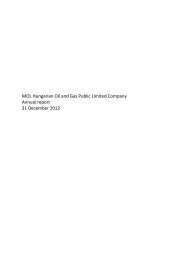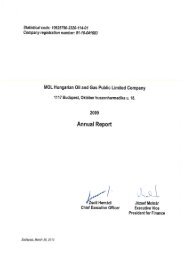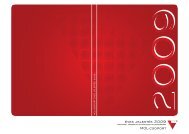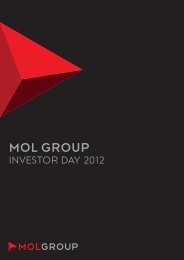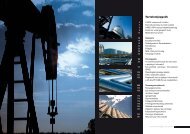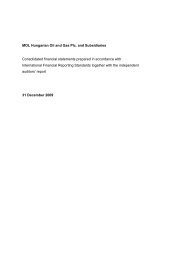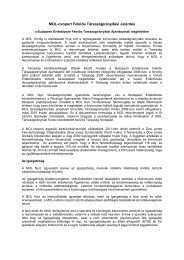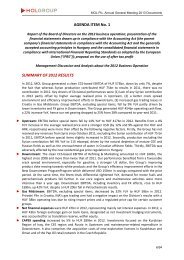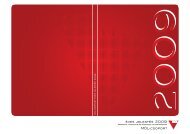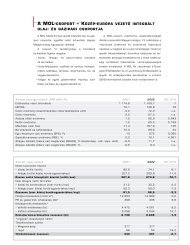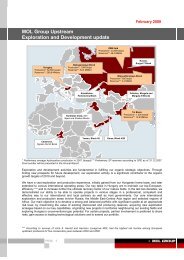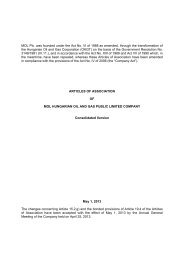MOL GROUP Annual Report
MOL GROUP Annual Report
MOL GROUP Annual Report
- No tags were found...
You also want an ePaper? Increase the reach of your titles
YUMPU automatically turns print PDFs into web optimized ePapers that Google loves.
In Slovakia sales volumes recovered in2010Romanian retail volumes decreased by2% on lower number of stationsSignificant increase in Croatia, 7%even without INAHungarian Petroleum Association, the Hungarian retail fuel market decreased by9% in 2010 vs. 2009). Main reasons of the demand decrease were the still depressedeconomic environment, outbound fuel tourism to the neighbouring countries andthe higher retail fuel prices resulted from higher product quotations, VAT and excisetax compared to the previous year. Moreover, the most price sensitive customersturned to white pumpers and also consider E85 as an alternative product offerin depressed economic climate. Our gasoline, diesel and LPG sales decreasedby 16%, 7% and 4%, respectively. The retail market was characterized by strongprice competition both in fuel and non-fuel sector and our retail fuel market sharedecreased slightly (35.8% in 2010 vs. 36.5% in 2009), according to MÁSZ. The ratioof fleet card sales to our total fuel sales increased to 39% in 2010 from 35.5% inbase year. This was a relative improvement due to the drop of cash purchases. Shopsales decreased by 4% in 2010 compared to 2009 due to the fact that economiccrisis is pushing costumers away from convenience retail channel and also from carwash business. Price increase of tobacco products could not balance lower sales oftraditional food products like soft drinks, alcohol products and chocolates.In Slovakia, our total retail fuel sales volume increased by 13% in 2010 year-on-year,in line with the start of economic recovery and partially as a result of reduced excisetax rate of diesel since 1 February. The increase both in gasoline and diesel sales isalso attributable to the effort of the business to strengthen customer loyalty andto gain new customers through the BONUS program. The increase in gasoline saleswas 3% in 2010 and the growth in diesel sales was 21% year-on-year due to transittraffic (5% and 24% growth in the Q4 2010 respectively). The fuel card sales were 9%higher than in 2009 due to diesel sales. Despite of the growth, the proportion of fuelcard sales in total fuel sales fell by 0.9 percentage points to 28% in 2010 year-on-year.In Romania, our fuel sales decreased by 2% which is lower than the trend on themarket in 2010, <strong>MOL</strong>’s market share increased to over 11%. The decrease in salesvolume mainly caused by the lower number of filling stations and the lower marketdemand. In addition the average throughput per site increased by 3.5% year-onyearas a result of stronger efforts taken to boost network’s efficiency. The fuelcard sales volume was mainly affected by the economic downturn and decreasedby 7% in 2010 vs. 2009. The shop sales revenue went up by approximately 5%(RON terms) in 2010, exceeding the average Romanian retail market performance.In Croatia, retail sales volume increased by 487 kt in 2010 year-on-year includingINA’s full year contribution (478 kt). Croatian retail sales volume, excluding INA,which practically means Tifon’s performance increased by 7% year-on-year andamounted to 150 kt in 2010. Additionally according to the decision of the CroatianCompetition Agency INA Group was obliged to sell 14 filling stations of Crobenz.Significant operating profitimprovement in 20106% higher integrated petrochemicalmargin1% increase in polymer productionOngoing sales and marketing strategyimplementation – focusing and differentiationOlefin sales - improves steam crackerutilizationPetrochemicals segment hit the highest ever net sales figure by achieving 35%improvement in 2010, compared to the preceding year. This improvement wascompensated by the significant increase in raw material cost. In 2010 the operatingprofit excluding special items of Petrochemical segment reached HUF 1.4 bn andimproved significantly by HUF 16.6 bn compared to the operating loss in 2009.The main reasons for the profit improvement were the increasing integratedpetrochemical margin, the higher olefin product prices, the lower electricityprices, the higher production and sales volumes, and efficiency increase effortswhich were reduced by the unfavorable change of the exchange rates.The integrated petrochemical margin was 323 EUR/t in 2010. The naphthaquotation in USD-terms increased the level of of last year by 34%, which wasoffset by the 20-47% increase of polymer quotations in EUR-terms. The US dollarstrengthened by 5% against EUR, and the HUF strengthened by 2% against EUR,which had deteriorating impact on the results.In 2010, the monomer and polymer production volumes increased by 1-1%,compared to the previous year. The periodical maintenance works in the Olefin-2plant (TVK) and polymer plants both in TVK and SPC in 2010 required lesstime than in 2009, therefore the available capacity was higher in 2010. Recordproduction was achieved by HDPE-2 unit in TVK with 223 kt. In 2010, within thetotal polymer production the proportion of LDPE was 19%, HDPE was 37% and PPwas 44%, showing the increased proportion of HDPE.Sales and marketing strategy can be characterized by two major goals – focusingand differentiation. Exploiting the favorable geographic location, the strategysets key development areas in the field of logistics, product development andtight customer relations, and lays higher emphasis on markets in Central Europe.In 2010 sales performance has been improved by achieving higher price levelswhile polymer inventories were kept at a low level. By improving the customerportfolio, the ratio of sales to spot destinations reduced from 8% in the previousyear to 6% in 2010.The Petrochemical segment of <strong>MOL</strong> is an active player in the regional olefinbusiness. Increasing by-products sales improves the capacity utilization of theolefin plants. During the first year of the crude C4 sales contract with our Polishpartner, Synthos - we gained positive experiences in the cooperation. Borsodchem,our strategic partner in the polymer business in Hungary has stabilized its positionsand takes over the regular supplies of ethylene, in accordance with our longterm supply contract. Pyrolysis oil sales to the carbon black unit in Tiszaújvárosimproved significantly in 2010, due to the upturn in the tyre industry.Management Discussionand AnalysisRegional coverage with more than1,600 petrol stations in 11 countriesConsiderable recovery in plasticsdemand and increasing product price,offset by higher feedstock costsThe Group operated 1,623 filling stations as of 31 December 2010, including 364in Hungary, 467 in Croatia, 208 in Slovakia, 205 in Italy, 126 in Romania, 109 inBosnia and Herzegovina, 66 in Austria, 33 in Serbia, 26 in the Czech Republic, 18 inSlovenia and 1 in Montenegro.Petrochemicals OverviewThe global economic recovery brought steady demand in the LDPE and PPmarkets. Quoted prices increased by 43-45%. However HDPE was not able tokeep up with this trend. The favorable tendencies in the Petrochemical segment’smarkets were moderated by raw material cost that increased by 43% in 2010.Although the annual average integrated petrochemical margin has improved by6%, this level is still behind the year 2008 figure by 21%. We kept strict measureson managing costs and working capital in 2010.Focus on cost management andenergy efficiency improvementContinue with SPC developmentproject to strengthen the positionof the Petrochemical DivisionCommitment to improve energy efficiency is deeply rooted in strategicthinking at the petrochemical segment. In response to the thriving importanceof environmental protection and increasing energy prices, action plans weredeveloped in connection with technologies and a new operational model wasimplemented for energy management. This will further improve the costefficiency of the overall energy process to the benefit of the environment. Weare consequently implementing our energy strategy formulated in 2008. In the2008-2010 period we spared 48 kt of CO2 via sustainable improvement actionsand individual energy projects.In the future petrochemical industry remains increasingly competitive, settingfurther challenges in the business. To keep and further strengthen competitiveadvantages, the Petrochemical segment is committed to continue its strategicdevelopment programs and seeking for new business opportunities. ContinuingSPC development project will provide a firm basis for the future position of70 <strong>MOL</strong> Group ANnual <strong>Report</strong> 2010 71



